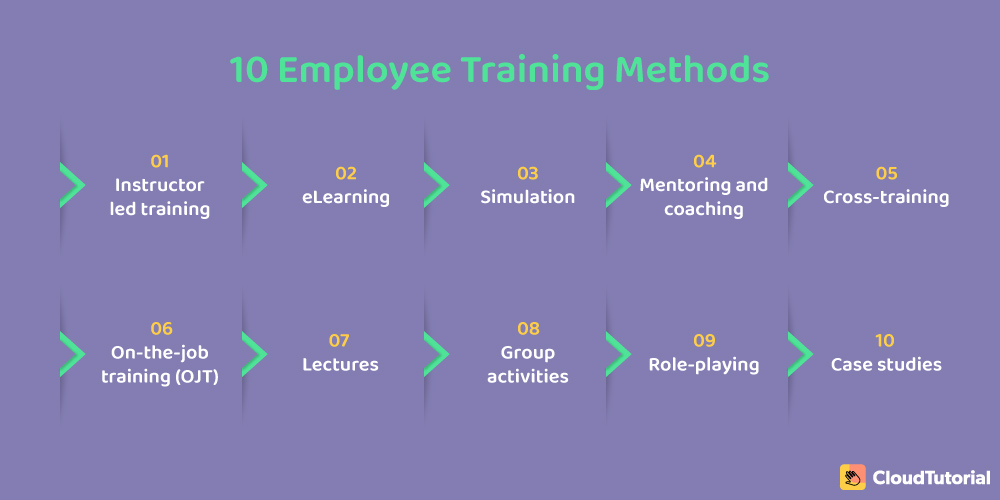Have you ever thought that why do employees need training? What type of training do they need? Are there any methods to perform training?
Such types of questions usually arise in your mind. The primary goal of conducting employee training is to enhance employee performance to a great extent.
So let’s get started with the article to understand more about employee training. The following table of content depicts the list of essential points that we are going to cover.
Table of Content
What is Employee Training and Development?
Nowadays, companies worldwide train their employees with the latest upcoming technologies using advanced educational methods and programs.
However, many companies invest more in employee training and development programs to motivate employees and build a robust skilled workforce within the organization.
Employee training and development are innovative and impressive techniques that help companies of all sizes and shapes organize different training types for their employees.
According to the 2019 Workplace Learning Report from LinkedIn,

Incorporating employee training programs in your organization makes it evident that employees can gain more knowledge and skills to enhance potential and optimum performance.
In simple words, training is a process to teach an employee how to deal with specific tasks and activities. At the same time, development deals with growth and acquiring skills that may be beneficial for future purposes.
Benefits of Employee Training and Development
-
Employee performance enhancement
The primary objective of employee training is not only to enhance business productivity but also to enhance employee performance to a great extent.
How?
The training program helps the employees to have expertise in various technologies, working scenarios, and many others that bring a positive impact on business growth.
Whatever impressive knowledge and skills they learn, it empowers them to deliver an effective quality of work with a faster turnaround rate.
Moreover, new hires get an opportunity to learn their roles and responsibilities related to business work. The organization is well-aware of the targets to be completed and interactive tools to make their working more smooth.
-
The rise in employee engagement
The more the employees are engaged in their work, the more chances of enhanced productivity level come into action.
Organizing and conducting training for the employees typically gains more performance improvement for employee engagement.
Usually, two-way communication occurs for sharing opinions and the internal workings of a team that exists within the organization. Employees, from the bottom line, remain more up-to-date with all the working scenarios.
-
Improved loyalty and retention
It’s quite obvious that the hiring process and onboarding activities are very time-consuming and costly. Whereas the robust products and services to enhance business performance and engagement is possible using improved employee retention.
The training and development program helps employees to enhance their value and productivity for the long term. A company can better find their valuable resources to verify the fact that they are following the right path to achieve learning objectives.
The biggest comfort that the company achieves is grabbing more opportunities to hire; thereby minimizing the costs of recruiting and onboarding for your business.
-
More chances of job satisfaction and motivation
With an appropriate and robust training and development program, it becomes quite obvious that employees easily grab the chance to learn the new technologies. On the other hand, the company can easily offer more job opportunities to new employees on a large scale.
-
Make customers happy
The primary goal of a company is to organize and schedule knowledge base training for the employees to grab more understanding of knowledge and information regarding the organization.
Of course, it’s going to benefit the company’s growth and productivity. Using a better training program, productive team members can quickly serve customers with efficient customer service.
These were the leading benefits that the company must know when they are planning to organize and schedule training programs as per their needs.
Build an advanced knowledge base for your customers and give them answers fast – real fast.
Take your app and help center to the next level with CloudTutorial.
10 Employee Training Methods for Workplace Training

Before we strive to understand the essential training methods, we will have a short overview of employee training types that occur in many organizations.
- Orientation: Welcoming new joiners in the organization by providing training on topics like company overview, vision, mission, and other administrative processes are orientation training.
- Onboarding: A series of learning sessions that helps new hires acquire the crucial skills they need is a part of onboarding training.
- Technical training: A training program specifically designed for technical skills like programming, data analysis, and others implies technical training.
- Soft skills training: A training program that helps the workforce to deal with boosting personal elements like leadership, emotional intelligence, and even communication are soft skills training.
- Products and services training: A specific training program that helps employees know more about the latest features, products, and services to gain customer support service is products and services training.
- Leadership training: Experienced employees, when received the promotion, need to be trained with skills like decision-making attributes and other project management approaches defined as leadership training.
- Safety training: The learning and development skills enable the company’s public-sector knowledge workers to opt for health and safety training and stay compliant with industry standards.
Generally, there are different types of training available in the market. Such training types are divided into the following categories:
| Traditional Training Methods | Modern Training Methods |
|---|---|
| Instructor-led training | eLearning |
| Mentoring and coaching | Simulation |
| Cross-training | On-the-job Training |
| Lectures | Role-playing |
| Group activities | Case Studies |
-
Instructor-led training
Using instructor-led training, the teacher or instructors can quickly answer the fly’s questions and provide the employees with extra training resources.
The employees can quickly grab the understanding of the specific tasks or activities individually in order to enhance the learning experience.
However, such training approaches are cost-effective and time-consuming compared to other available online training options. But it entirely depends on your training and development strategy, like how and what you apply in your learning skills.
Many employees are still social learners; they just need to select the best available option to learn either personally or in groups to enhance employee growth to a great extent.
-
eLearning
Almost everything in this world is becoming online. Many organizations adopt an online learning management system for their employees to learn using their mobile devices anytime, anywhere.
The employees can easily enhance their knowledge and skills using eLearning tools like online videos, lectures, tutorials, and interactive graphical representation to gain more employee engagement and achieve business goals on a large scale.
The most significant leading point of eLearning is the robust ability to train people at very low pricing. In addition to it, improving knowledge retention is possible using the eLearning approach to make better succession planning.
One of the essential best practices to maintain graphics and visuals is to keep them up-to-date as and when required.
-
Simulation
Is it possible to train employees using augmented or virtual reality devices?
Yes, training instructor uses the latest innovative devices like VR headsets and augmented reality devices to train the employee. Many organizations are using these technologies to enhance training programs.
Of course, simulation training is very costly as compared to other eLearning training programs. The primary reasons behind it are performed individually, and it should strictly adhere to the company policies to adopt such a training approach.
-
Mentoring and coaching
One-on-one hand training or personal training is the best example of the mentoring and coaching method. As the name suggests, two different methodologies come under this category.
Mentoring means providing the training by someone that works within the organization. On the other hand, an external business’s expert talent offers professional training for your organization’s employees.
For example, the organization’s sales department primarily uses mentoring and coaching approaches as they need hands-on sessions by experienced professionals.
Build an advanced knowledge base for your customers and give them answers fast – real fast.
Take your app and help center to the next level with CloudTutorial.
-
Cross-training
If I say that a marketing person can train a graphic designer or a salesperson to train a mobile app developer, it is cross-training. So, the individual in your organization possesses a strong ability to perform duties out-of-scope of their job description and cross-training employees.
Who benefits the most from cross-training?
Both the employees and company benefit from cross-training. The employee with new skills quickly becomes more valuable and enhances the career-oriented approach, whereas the company creates an impressive workforce.
-
On-the-job training (OJT)
OJT is the best and effective employee training method that helps employees grab new skills, knowledge bases, and competencies even when they are on their job.
Using a talent and performance management system, HR professionals are the best example of software vendors training employees.
OJT is also referred to as one-on-one learning and is used when multiple resources are available to support employees during the training program. Not only this, but there are also techniques for knowledge transfer from one employee to another employee without any hassle.
-
Lectures
A large number of employees are provided with special training like lectures that are just like eLearning with less investment.
One of the significant constraints for employee training is that it is relatively less engaging than other approaches because perfect hours concentration is a must for this training approach.
-
Group activities
Employee learning can be easily enhanced by developing training and development program activities like workshops, seminars, and group discussions on various topics to a great extent.
Group activities typically include one-to-many and many-to-many training, which enables employee development programs to be more productive.
Such an employee training method is ideal for a team that is specifically working on exchanging knowledge and solving problems efficiently.
-
Role-playing
The role-playing approach of employee training programs typically follows a controlled scenario. By considering different points-of-view of training, employees work through the role-playing activity.
This highly-effective method is the perfect choice for the teams intending to develop empathy, but it’s not well-suited for simple, straightforward topics.
More employee time is required, thereby taking too much time while away from an entire department during the training program.
-
Case studies
Finally, based on the essential reading, some topics for employee training come into action. Case studies, in particular, allows employees to learn about real workplace issues. Employees, being at their location or while working, enables team-building sessions with other employees.
Case studies specifically deal with focused topics, but more complex issues will likely require more advanced employee training programs.
Analyzing and learning from real-world facts and figures, case studies help employees to read during their free time or can discuss even during group training.
How to Choose the Right Workplace Training Methods?

After understanding the detailed information on employee training and development programs, now it’s high time to grasp the knowledge related to selecting the best training methods.
- Determine the training goals
Different companies with different needs have numerous reasons to offer training to their employees.
Some may provide training related to new skills and technologies, while others may apply contrasting training techniques to apply existing skills to employees.
All in one, the company must be ready with the training goals to enhance business productivity and performance.
- Recognize the audience
What did you say? Audience?
Yes, it’s a marketing concept but applies the same to training programs as well. From training perspectives, the audience can be new employees, seasoned employees, or senior executives of the company.
The audience type basically decides the level of training is conducted.
- Constraints
Companies must always be ready to deliver the training under certain constraints. Yes, you read it correctly.
While classroom training suits the best for upper management learning leadership skills and techniques, the company might not afford to deal with such a form of the face-to-face training method.
On the other hand, a computer-based or web-based option works well as it suits the best for the training budget.
Time and the training resources and materials for the training topic are also the best examples of constraints.
Conclusion
Hope you got a clear understanding of how employee training is beneficial for improving business performance.
Employee training and development programs help employees as well as organizations to bring motivation among the team members working within the organization.
The organization must select the appropriate training methods that suit them best as per the business needs in order to remain on the same page.
Try it out before you decide.
Create a test article NOW!
Using this tool, all you have to do is add your first test article and see how it looks. Now, you don’t have to sign-up or login into CloudTutorial software just to check how your first article appears.

